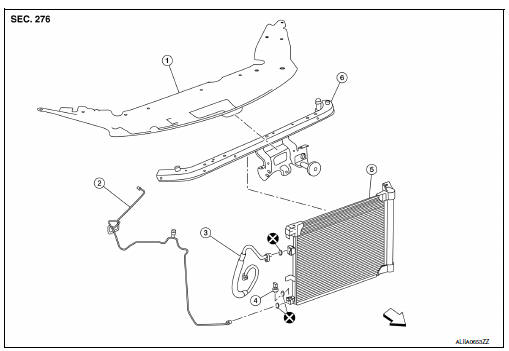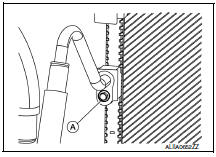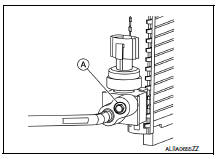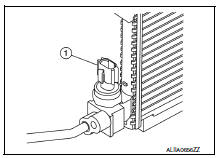Nissan Sentra Service Manual: Condenser
Exploded view

- Core support upper cover
- High-pressure pipe
- High-pressure flexible hose
- Refrigerant pressure sensor
- Condenser and liquid tank assembly
- Core support upper
 Front
Front
Condenser
Condenser : removal and installation
REMOVAL
- Discharge the refrigerant. Refer to HA-23, "Recycle Refrigerant".
- Reposition the hood lock assembly. Refer to DLK-154, "HOOD LOCK CONTROL : Exploded View".
NOTE:
Disconnection of the hood release cable is not necessary.
- Remove the core support upper. Refer to HA-39, "Exploded View".
- Remove the front grille. Refer to EXT-23, "Removal and Installation".
- Disconnect the harness connector from the refrigerant pressure sensor.
- Remove the bolt (A) that retains the high-pressure flexible hose to the condenser, then disconnect the high-pressure flexible hose from the condenser and liquid tank assembly.
CAUTION:
Cap or wrap the joint of the hose with suitable material such as vinyl tape to avoid the entry of air.

- Remove the bolt (A) that retains the high-pressure pipe to the condenser, then disconnect the high-pressure pipe from the condenser and liquid tank assembly.

- Remove the condenser and liquid tank assembly.
INSTALLATION
Installation is in the reverse order of removal.
CAUTION:
- Do not reuse O-rings.
- Apply A/C oil to the O-rings of the condenser for installation.
- After charging refrigerant, check for leaks. Refer to HA-21, "Leak Test".
Refrigerant pressure sensor
Refrigerant pressure sensor : removal and installation
REMOVAL
- Discharge the refrigerant. Refer to HA-23, "Recycle Refrigerant".
- Reposition the hood lock assembly. Refer to DLK-154, "HOOD LOCK CONTROL : Exploded View".
NOTE:
Disconnection of the hood release cable is not necessary.
- Remove the core support upper. Refer to HA-39, "Exploded View".
- Disconnect the harness connector from the refrigerant pressure sensor.
- Remove the refrigerant pressure sensor (1) from the liquid tank on the condenser.
CAUTION:
Do not damage the condenser fins.

INSTALLATION
Installation is in the reverse order of removal.
CAUTION:
- Do not reuse the O-ring.
- Apply A/C compressor oil to the new O-ring for installation.
- After charging refrigerant, check for leaks. Refer to HA-21, "Leak Test".
 Cooler pipe and hose
Cooler pipe and hose
Exploded view
High-pressure service port
High-pressure pipe
Expansion valve
Low-pressure service port
Low-pressure flexible hose
Compressor
Refrigerant pressure sensor
Condenser ...
 Heating and cooling unit assembly
Heating and cooling unit assembly
Exploded view
With air conditioning
Defroster seal
Center ventilator seal
Upper distribution module
Side ventilator seal (LH)
Blower motor
Blower unit
Intake door motor
Power tr ...
Other materials:
Removal and installation
Audio unit
Exploded view
Audio unit
Audio unit bracket (LH)
Audio unit bracket (RH)
Removal and installation
Removal
Disconnect the negative battery terminal. Refer to pg-50, "removal and
installation (battery)".
Remove cluster lid c lower. Refer to ip-20, "re ...
Trunk room lamp
Removal and Installation
Warning:
Do not touch bulb while it is lit or right after being turned off.
Burning may result.
Caution:
Do not touch glass surface of the bulb with bare hands or allow oil or
grease to get on it to prevent
damage to bulb.
Release the tab (b) to open the lens.
...
Push-button ignition switch positions
LOCK (Normal parking position):
The ignition switch can only be locked in this
position.
The ignition switch will be unlocked when it is
pushed to the ACC position while carrying the
Intelligent Key or with the Intelligent Key inserted
in the port.
The ignition switch will lock when any d ...
